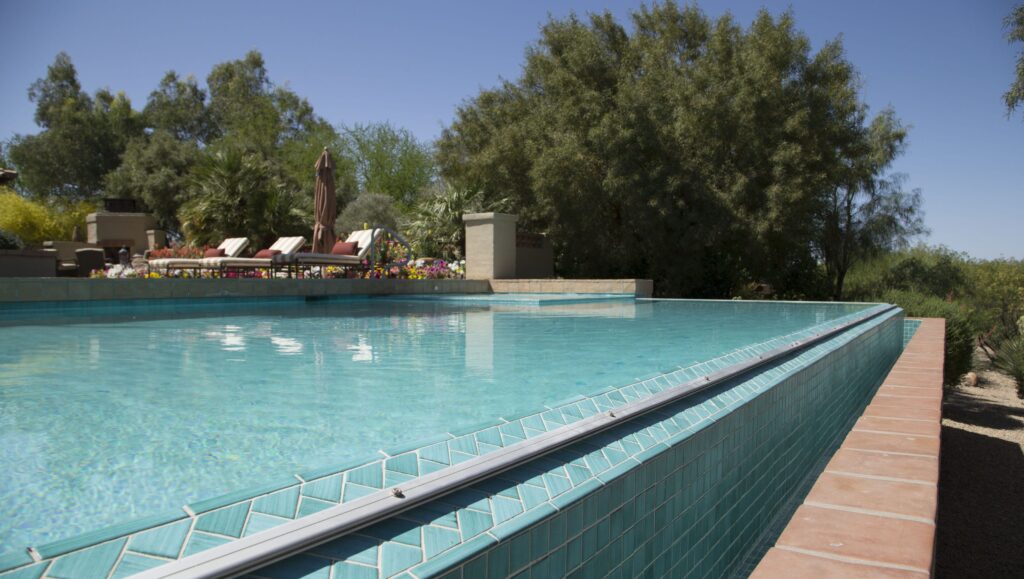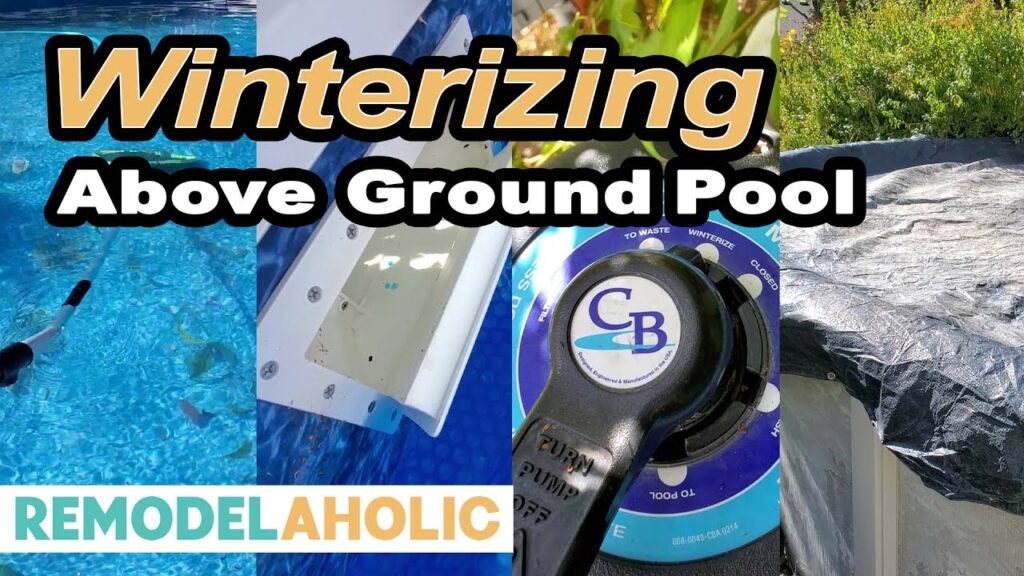In “Mastering The Art Of Water Chemistry In Your Above Ground Pool,” you will discover the essential tips and tricks to maintain the perfect balance in your above ground pool’s water chemistry. Whether you are a seasoned pool owner or a beginner, this article will guide you through the process of achieving crystal clear and safe water for your pool. With the right knowledge and understanding, you can ensure that your above ground pool remains a refreshing oasis all season long.
This image is property of Amazon.com.
Understanding Water Chemistry
Importance of water chemistry in above ground pools
Maintaining proper water chemistry in your above ground pool is of utmost importance for several reasons. First and foremost, balanced water chemistry ensures a safe and healthy swimming environment for you and your loved ones. By keeping the water chemistry in check, you prevent the growth of bacteria, algae, and harmful microorganisms that can cause infections and waterborne diseases.
Additionally, balanced water chemistry helps to protect the integrity of your pool equipment and surfaces. If the water chemistry is off balance, it can lead to corrosion of metal parts, staining of pool surfaces, and even damage to the pool liner or filter system. By understanding water chemistry, you can prolong the lifespan of your pool equipment and avoid costly repairs or replacements.
Basic components of water chemistry
Water chemistry is determined by several key components that need to be monitored and maintained at specific levels. These components include pH level, alkalinity, calcium hardness, cyanuric acid levels, and sanitizer levels. Each component plays a crucial role in the quality of your pool water, and neglecting any of them can lead to imbalances and potential issues.
Factors affecting water chemistry
While maintaining proper water chemistry is essential, it’s essential to recognize the various factors that can affect it. Factors such as weather conditions, pool usage, environmental debris, and even the use of certain pool chemicals can impact the balance of your pool water. By understanding these factors, you can make necessary adjustments and ensure that your water chemistry remains optimal.
Common water chemistry terms
Before delving into the specifics of testing and balancing pool water, it’s important to familiarize yourself with some common water chemistry terms. Understanding these terms will enable you to comprehend the testing process and interpret the results accurately.
Some common water chemistry terms include pH, alkalinity, calcium hardness, cyanuric acid, sanitizer, shock treatment, and algae. By gaining a solid understanding of these terms, you will be better equipped to effectively manage your pool’s water chemistry.
Testing and Balancing Pool Water
Importance of regular water testing
Regularly testing your pool water is a crucial step in maintaining its quality. It allows you to monitor the chemical levels and make any necessary adjustments to ensure optimal water chemistry. Without regular testing, imbalances can go unnoticed and lead to various issues such as cloudy water, algae growth, or even skin and eye irritations.
Types of water testing kits
There are several types of water testing kits available to help you measure your pool water’s chemical levels accurately. These kits typically include testing strips, liquid test kits, or digital testers. Each type has its own advantages and provides accurate readings for different chemical components.
Testing strips are convenient and easy to use, allowing you to quickly test multiple chemical levels simultaneously. Liquid test kits may require more time and effort, but they often provide more precise results. Digital testers offer a user-friendly approach with instant and accurate readings, making them a popular choice for pool owners.
Testing frequency
The frequency of testing your pool water depends on various factors such as pool usage and environmental conditions. As a general guideline, it is advisable to test your water at least once a week, particularly during the peak swimming season. However, if your pool experiences heavy usage or adverse weather conditions, more frequent testing may be necessary.
Understanding test results
Interpreting the results of your water tests is essential to understanding the current state of your pool’s water chemistry. Each component will have its own acceptable range, and it’s important to compare your test results to these ranges. By doing so, you can identify any imbalances and take the necessary steps to correct them.
Balancing pH level
The pH level of your pool water refers to its acidity or alkalinity. It is crucial to keep the pH within a specific range to maintain swimmer comfort and prevent equipment damage. A pH reading below 7 indicates acidic water, while a reading above 7 indicates alkaline water.
To adjust the pH level, chemicals known as pH increasers or pH decreasers can be used. These chemicals are readily available and can help you bring the pH back into the appropriate range. Regular monitoring and adjustment of the pH level will ensure that your pool water remains balanced and safe for swimming.
Adjusting alkalinity
Total alkalinity acts as a buffer that helps to stabilize pH levels in your pool water. It is essential to maintain proper alkalinity levels to prevent pH fluctuations and ensure the overall stability of your water chemistry.
If alkalinity levels are too high, you can use chemicals known as alkalinity decreasers to bring them down. Conversely, if alkalinity levels are low, alkalinity increasers can be added to raise them. Regular testing and adjustment of alkalinity levels will help you maintain a balanced and harmonious pool environment.
Controlling calcium hardness
Calcium hardness refers to the amount of dissolved calcium in your pool water. Proper calcium hardness levels are necessary to prevent issues such as corrosion or scaling. Low calcium hardness can result in the leaching of calcium from pool surfaces, which can lead to deterioration. On the other hand, high calcium hardness can cause scaling, resulting in cloudy water and potential equipment damage.
To adjust calcium hardness, specific chemicals can be used to either raise or lower the levels. By maintaining appropriate calcium hardness, you ensure the longevity and functionality of your above ground pool.
Stabilizing cyanuric acid levels
Cyanuric acid, also known as a stabilizer or conditioner, is used to prevent the degradation of chlorine caused by sunlight. It plays a crucial role in maintaining proper chlorine levels and improving the effectiveness of sanitizers.
Regular testing and monitoring of cyanuric acid levels are essential to ensure they remain within the recommended range. If levels are too low, cyanuric acid stabilizers can be added, while if levels are too high, dilution or partial water replacement may be necessary. By stabilizing cyanuric acid levels, you can optimize the performance of your sanitizers and maintain a healthy pool environment.
Maintaining Proper Sanitization
Role of sanitizers in pool water
Sanitizers are chemicals used to kill and prevent the growth of bacteria, viruses, algae, and other harmful microorganisms in your pool water. They play a crucial role in ensuring the water remains clean and safe for swimming.
By effectively sanitizing your pool, you minimize the risk of waterborne illnesses and create a pleasant swimming experience. Sanitizers work by oxidizing and disinfecting the water, eliminating any potentially harmful contaminants.
Different types of sanitizers
There are various types of sanitizers available, each with its own unique characteristics and advantages. The most common and widely used sanitizer is chlorine, which comes in different forms such as tablets, granules, or liquid. Chlorine is effective in killing bacteria and viruses, but it requires regular monitoring and adjustment to maintain appropriate levels.
Another popular sanitizer is bromine, which is known for its stability and effectiveness in hot water environments. Other options include non-chlorine shock treatments, which can be used alongside chlorine to provide additional oxidation and eliminate contaminants.
Choosing the right sanitizer for your above ground pool
When selecting a sanitizer for your above ground pool, it’s essential to consider factors such as cost, effectiveness, and personal preferences. Chlorine is the most common choice due to its effectiveness and affordability. However, if you have sensitive skin or prefer an alternative to chlorine, bromine might be a suitable option.
It’s important to follow manufacturer instructions and guidelines when using sanitizers to ensure proper dosage and application. Regular testing of sanitizer levels is also crucial to maintain optimal water chemistry and protect swimmers from potential health risks.
Applying and testing sanitizer levels
Applying sanitizers to your pool water is a straightforward process that requires following the manufacturer’s instructions. Whether you’re using chlorine tablets, granules, or liquid, it’s important to add the appropriate amount to maintain the recommended sanitizer levels.
To ensure the effectiveness and efficiency of the sanitizers, regular testing is necessary. Test kits specifically designed to measure sanitizer levels can help you determine if the chlorine or bromine levels are within the desired range. By regularly monitoring and adjusting sanitizer levels, you can guarantee a safe and sanitized swimming environment.
Alternative sanitization methods
In addition to traditional sanitizers like chlorine and bromine, there are alternative methods available for those who prefer a different approach. Saltwater systems use a salt chlorinator to convert salt into chlorine, providing a more natural and hassle-free sanitation method. UV (ultraviolet) systems use UV light to eliminate bacteria and other microorganisms, complementing traditional sanitizers.
These alternative sanitization methods offer their own benefits, such as reduced chlorine odors or reduced skin and eye irritation. However, it’s important to note that these systems still require regular testing and maintenance to ensure optimal water quality.
Preventing and Treating Algae
Understanding algae growth
Algae are microscopic organisms that can quickly multiply and cause discoloration, cloudiness, and even slimy surfaces in your above ground pool. Algae spores can enter your pool through various sources, including wind, rain, or contaminated equipment and swimwear.
Understanding the conditions that promote algae growth is crucial for preventing and treating this common pool problem. By staying vigilant and taking proactive measures, you can keep your pool water crystal clear and algae-free.
Factors contributing to algae growth
Several factors contribute to the growth of algae in your above ground pool. Warm temperatures, high pH levels, inadequate sanitizer levels, and imbalanced water chemistry can create an environment conducive to algae growth. Insufficient circulation and lack of regular maintenance can also contribute to the problem.
By addressing these factors and ensuring optimal water chemistry and circulation, you can prevent algae from gaining a foothold in your pool. Regular testing and maintenance are key to minimizing the risk of algae growth.
Types of algae commonly found in above ground pools
Different types of algae can occur in above ground pools, each with their own characteristics and treatment methods. Green algae is the most common type, creating a greenish tint on pool surfaces and causing water cloudiness. Yellow/mustard algae, known for its slimy texture, tends to cling to pool surfaces and can be challenging to eliminate. Black algae, although less common, poses a significant challenge due to its stubborn and resilient nature.
Identifying the type of algae infestation in your pool is crucial for selecting the appropriate treatment methods. By understanding the unique characteristics of each algae type, you can effectively eliminate the problem and prevent future outbreaks.
Preventing algae formation
Prevention is always better than a cure when it comes to algae. By implementing proper pool maintenance practices, you can significantly reduce the risk of algae formation. Regularly testing and adjusting water chemistry, maintaining appropriate sanitizer levels, and ensuring proper circulation and filtration are essential steps in preventing algae growth.
Regular brushing and vacuuming of pool surfaces, especially in hard-to-reach areas, can also help prevent algae buildup. Additionally, removing debris such as leaves or grass clippings from your pool and regularly cleaning the filter system will aid in algae prevention.
Removing and treating algae
In the unfortunate event that algae growth occurs in your above ground pool, swift and appropriate action is necessary to eliminate the problem. The treatment method will depend on the type and severity of the infestation.
Shock treatments using chlorine or non-chlorine shock can be effective in eliminating algae, especially during the initial stages. Algaecides, specifically formulated to kill and prevent algae growth, can be used in combination with shock treatments for more stubborn infestations.
In severe cases, manual scrubbing and brushing of affected surfaces may be necessary to dislodge stubborn algae. Regular water testing and monitoring even after treatment will help prevent future algae outbreaks.
This image is property of Amazon.com.
Managing Chlorine Levels
Importance of proper chlorine levels
Chlorine plays a vital role in maintaining the cleanliness and safety of your above ground pool. It acts as a sanitizer, effectively killing bacteria and other harmful microorganisms. Without adequate chlorine levels, the water becomes a breeding ground for algae, bacteria, and viruses, posing health risks and diminishing the swimming experience.
Proper chlorine levels are essential for maintaining water clarity, preventing unpleasant odors, and protecting swimmers from potential infections. By managing chlorine levels effectively, you ensure a safe and enjoyable pool environment.
Using chlorine shock treatments
Chlorine shock treatments are a powerful method to effectively eliminate contaminants, restore chlorine levels, and maintain water clarity. These treatments involve adding a higher concentration of chlorine to the pool water, providing a shock to the system and oxidizing any impurities.
Regular shock treatments, especially after heavy pool usage or adverse weather conditions, help to break down organic matter, remove chloramines, and prevent the growth of algae. They play a crucial role in maintaining proper chlorine levels and preventing issues related to inadequate sanitation.
Determining chlorine demand
Determining the chlorine demand of your pool is essential to ensure the proper dosage of chlorine is added. The chlorine demand refers to the amount of chlorine required to achieve and maintain the desired sanitizer levels.
Various factors influence the chlorine demand, such as pool usage, temperature, and environmental conditions. By calculating the chlorine demand accurately, you can add the appropriate amount of chlorine and prevent chlorine deficiencies or overdosing.
Preventing chlorine-related issues
While chlorine is necessary for maintaining water cleanliness, it can also cause certain issues if not managed properly. Chlorine odors, skin and eye irritations, and bleaching of swimsuits are common problems associated with high chlorine levels.
To prevent these issues, it’s crucial to regularly monitor and adjust chlorine levels according to the recommended range. Proper pH, alkalinity, and cyanuric acid levels also play a role in chlorine effectiveness. By ensuring all components of water chemistry are balanced, you can maintain proper chlorine levels and minimize potential problems.
Addressing pH Imbalance
Effects of high or low pH levels
Maintaining the proper pH level in your above ground pool is crucial for several reasons. High or low pH levels can cause various issues and affect swimmers’ comfort and the overall pool environment.
If the pH level is too high (alkaline), it can lead to cloudy water, scale formation, or decreased sanitizer effectiveness. On the other hand, if the pH level is too low (acidic), it can cause skin and eye irritations, corrosion of pool equipment, and even damage to pool surfaces.
Causes of pH imbalance
Several factors can contribute to pH imbalance in your pool water. Environmental factors, such as rainfall or debris, can introduce contaminants that affect the pH. Pool usage, the addition of chemicals, or inadequate circulation can also disrupt pH levels.
By recognizing the potential causes of pH imbalance, you can take appropriate steps to prevent and address the issue. Regular testing and adjustment of pH levels will help you maintain a comfortable and safe pool environment.
Adjusting pH using chemicals
When pH levels deviate from the recommended range, adjustments can be made using specific chemicals. pH increasers, such as sodium carbonate or soda ash, can be added to raise pH levels. pH decreasers, such as sodium bisulfate or muriatic acid, can be used to lower pH levels.
It’s important to follow manufacturer instructions and guidelines when using these chemicals to avoid overcorrection or adverse effects. Gradual adjustments are recommended to achieve the desired pH range gradually.
Natural remedies for pH balance
In addition to chemical methods, there are natural remedies that can help restore pH balance in your above ground pool. Baking soda can act as a pH buffer, helping to stabilize and raise pH levels slightly. Vinegar can be used in small quantities to lower pH levels naturally.
However, it’s important to note that these natural remedies may have limitations in achieving precise pH adjustments. Regular testing, monitoring, and chemical adjustments may still be necessary to maintain stable pH levels.
This image is property of www.azcentral.com.
Controlling Total Alkalinity
Understanding the role of total alkalinity
Total alkalinity is an essential component of water chemistry that helps stabilize pH levels and prevent drastic fluctuations. It acts as a buffer, protecting against rapid pH changes and maintaining overall water balance.
By controlling total alkalinity, you ensure the stability and effectiveness of your pool’s water chemistry. It provides a solid foundation for maintaining optimal pH levels and prevents potential issues caused by pH imbalances.
Consequences of low or high alkalinity
Low total alkalinity levels can result in pH fluctuations, making it difficult to maintain the desired pH range. This can lead to issues such as etched or corroded pool surfaces, eye and skin irritations, and reduced sanitizer effectiveness. On the other hand, high total alkalinity levels can cause cloudy water, scale formation, and decreased pH responsiveness.
Maintaining the appropriate total alkalinity range is crucial for preventing these consequences and ensuring the overall stability of your pool water.
Adjusting total alkalinity levels
To adjust total alkalinity levels, specific chemicals can be used to either raise or lower them. Sodium bicarbonate, also known as baking soda, can be added to increase total alkalinity levels. If total alkalinity is high and needs to be lowered, muriatic acid or sodium bisulfate can be used.
It’s important to follow dosage recommendations and instructions provided by the chemical manufacturer. Regular testing and monitoring will allow you to maintain total alkalinity levels within the desired range.
Maintaining ideal alkalinity range
The ideal range of total alkalinity is typically between 80 and 120 parts per million (ppm) for most above ground pools. However, it is important to refer to the specific guidelines provided by your pool manufacturer or a water chemistry professional.
Regular testing and adjustment of total alkalinity levels will help you maintain the desired range and ensure the stability of your pool’s water chemistry.
Understanding Calcium Hardness
Importance of calcium hardness
Calcium hardness refers to the level of dissolved calcium in your above ground pool’s water. Maintaining proper calcium hardness levels is essential for the overall water balance and the integrity of your pool surfaces and equipment.
Insufficient calcium hardness can lead to the leaching of calcium from pool surfaces, causing deterioration, etching, or staining. On the other hand, high calcium hardness levels can result in scale formation, cloudy water, and even reduced sanitizer effectiveness.
Consequences of low or high calcium levels
Low calcium hardness levels can be detrimental to your pool’s structure, as it may cause corrosion, deterioration, or etching of plaster or concrete surfaces. It can also affect the longevity of vinyl liners, leading to wrinkling or tearing.
High calcium hardness levels, primarily in areas with hard water, can result in scale formation on pool surfaces, equipment, or plumbing. This can lead to decreased water flow, decreased equipment efficiency, and even potential damage.
Adjusting calcium hardness
To adjust calcium hardness levels, specific chemicals can be used to either raise or lower them. Calcium chloride can be added to increase calcium hardness levels, while dilution or partial water replacement may be necessary to lower them.
It’s crucial to follow manufacturer guidelines and dosage recommendations when using these chemicals. Regular testing and monitoring will help you maintain appropriate calcium hardness levels and protect your pool surfaces and equipment.
Preventing calcium build-up
Preventing calcium build-up requires regular maintenance and proper water chemistry management. Regular brushing and sweeping of pool surfaces will help to prevent the accumulation of calcium deposits. Additionally, balancing other aspects of water chemistry, such as pH and total alkalinity, will promote a harmonious pool environment and minimize the risk of calcium scaling.
This image is property of i.ytimg.com.
Maintaining Cyanuric Acid Levels
Role and importance of cyanuric acid
Cyanuric acid, also known as a stabilizer or conditioner, plays a crucial role in pool water management. It acts as a protective agent for chlorine, preventing the degradation of chlorine caused by sunlight exposure. By stabilizing chlorine levels, cyanuric acid improves the overall effectiveness and longevity of sanitizers.
Maintaining proper cyanuric acid levels is essential for ensuring adequate and consistent chlorination in your above ground pool. It helps to extend the lifespan of chlorine, reduce chlorine consumption, and provide a stable and sanitary swimming environment.
Effects of low or high cyanuric acid levels
Low cyanuric acid levels can result in reduced chlorine effectiveness, increasing the risk of bacteria and algae growth. It may also lead to quicker chlorine degradation, requiring more frequent sanitizing and higher chemical usage.
Conversely, high cyanuric acid levels can lead to chlorine lock, where chlorine becomes less effective in killing bacteria and microorganisms. It may result in cloudiness, reduced sanitizer efficacy, and difficulty maintaining proper water balance.
Testing and adjusting cyanuric acid levels
To ensure optimal cyanuric acid levels, regular testing is necessary. Test kits specifically designed to measure cyanuric acid levels can be used to monitor and adjust as needed. The ideal range for cyanuric acid is typically between 30 and 50 ppm, although specific guidelines may vary.
If cyanuric acid levels are too low, cyanuric acid stabilizers can be added to raise them. If levels are too high, dilution or partial water replacement may be necessary.
Preventing cyanuric acid accumulation
To prevent excessive cyanuric acid accumulation, it’s important to practice proper water management and maintenance. Avoiding overuse of stabilized chlorine products and regular monitoring of cyanuric acid levels will help prevent its build-up.
In areas with high cyanuric acid levels in the tap water, partial water replacement may be necessary to reduce overall cyanuric acid concentration. Regular testing, monitoring, and adjustment of cyanuric acid levels will ensure the stability and effectiveness of your pool’s water chemistry.
Dealing with Chemical Imbalances
Identifying signs of chemical imbalances
Chemical imbalances in your above ground pool can manifest through various signs and symptoms. Cloudy or discolored water, unpleasant odors, eye and skin irritations, or scaling on pool surfaces can all indicate potential imbalances in water chemistry.
By actively observing the condition of your pool and evaluating any noticeable changes or abnormalities, you can identify and address chemical imbalances promptly. Regular testing and monitoring of water chemistry parameters will help you maintain balance and prevent potential issues.
Common chemical imbalances and their causes
Several factors can contribute to chemical imbalances in your pool, resulting in issues such as pH fluctuations, algae growth, or ineffective sanitizer performance. Weather conditions, pool usage, environmental debris, or improper chemical dosing can all disrupt water chemistry.
By understanding the common causes of chemical imbalances, you can take the necessary preventive measures and make appropriate adjustments. Proper education and vigilance will help you maintain a safe and comfortable pool environment.
Steps to restore chemical balance
Restoring chemical balance in your above ground pool requires a systematic and step-by-step approach. The specific steps will depend on the nature and severity of the imbalance.
Begin by identifying the problem through testing and evaluation of current water chemistry. Adjustments can then be made using suitable chemicals or natural remedies, following manufacturer instructions and dosage recommendations.
Regular testing and monitoring should continue to ensure the effectiveness of the adjustments and maintain optimal water chemistry. By taking proactive measures and addressing chemical imbalances promptly, you can enjoy a clean and safe swimming experience in your above ground pool.
Mastering the Art of Water Chemistry in Your Above Ground Pool encompasses essential information and practical tips for maintaining optimal water chemistry in your pool. Understanding the importance of water testing, pH balance, sanitizer levels, algae prevention, and chemical maintenance is crucial for a safe, clean, and enjoyable swimming experience. By following the guidelines provided in this comprehensive article, you can confidently take control of your above ground pool’s water chemistry and ensure its long-term durability and the well-being of all swimmers.









